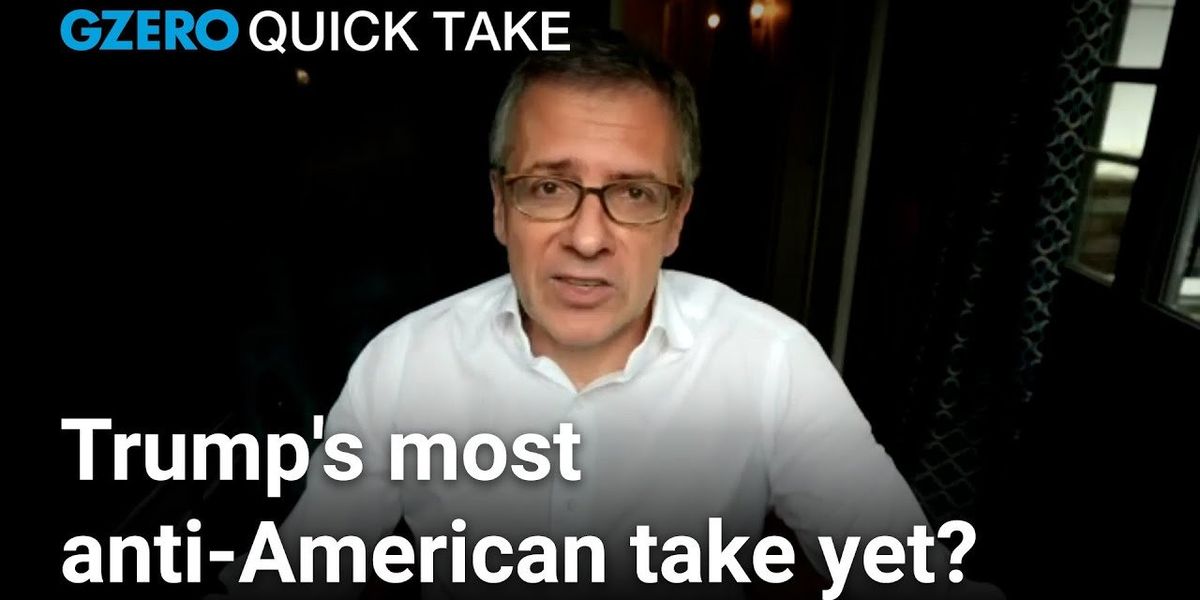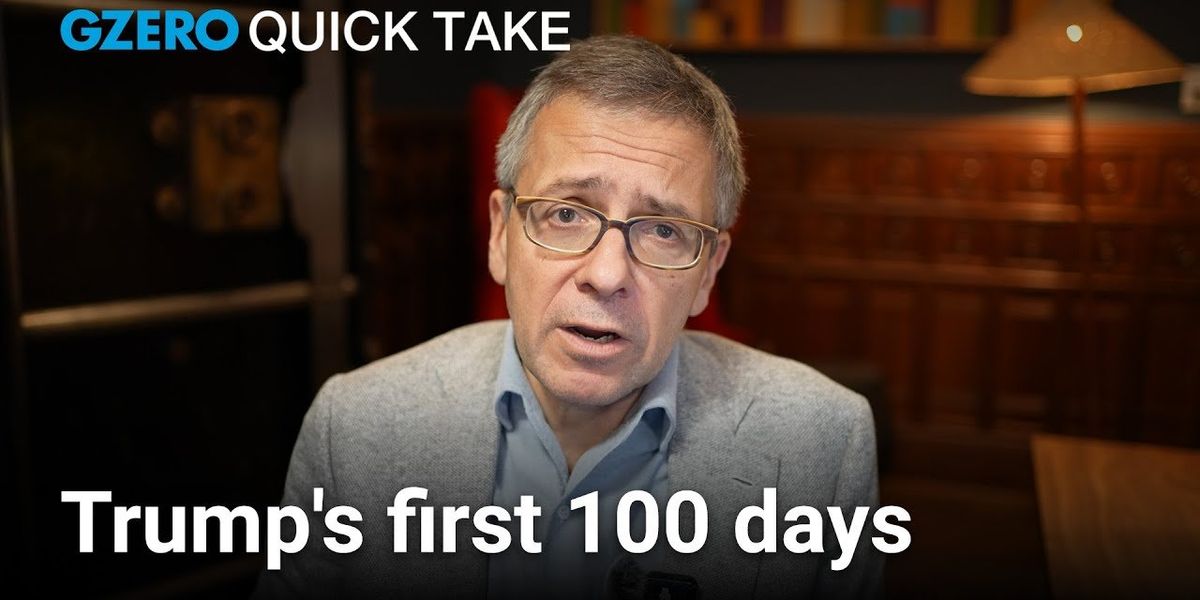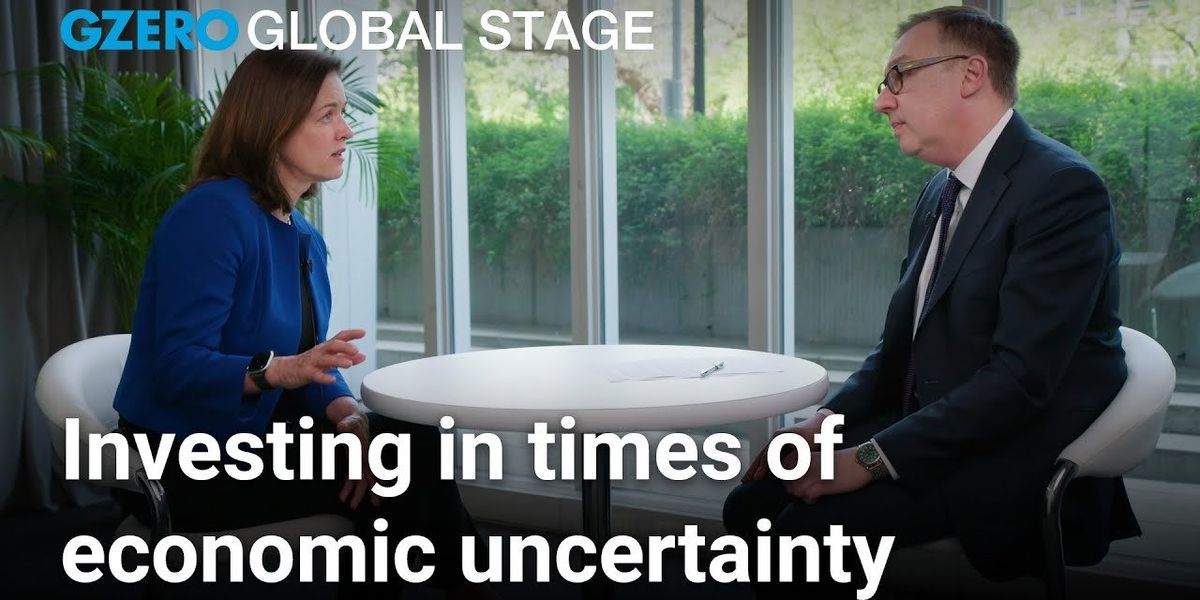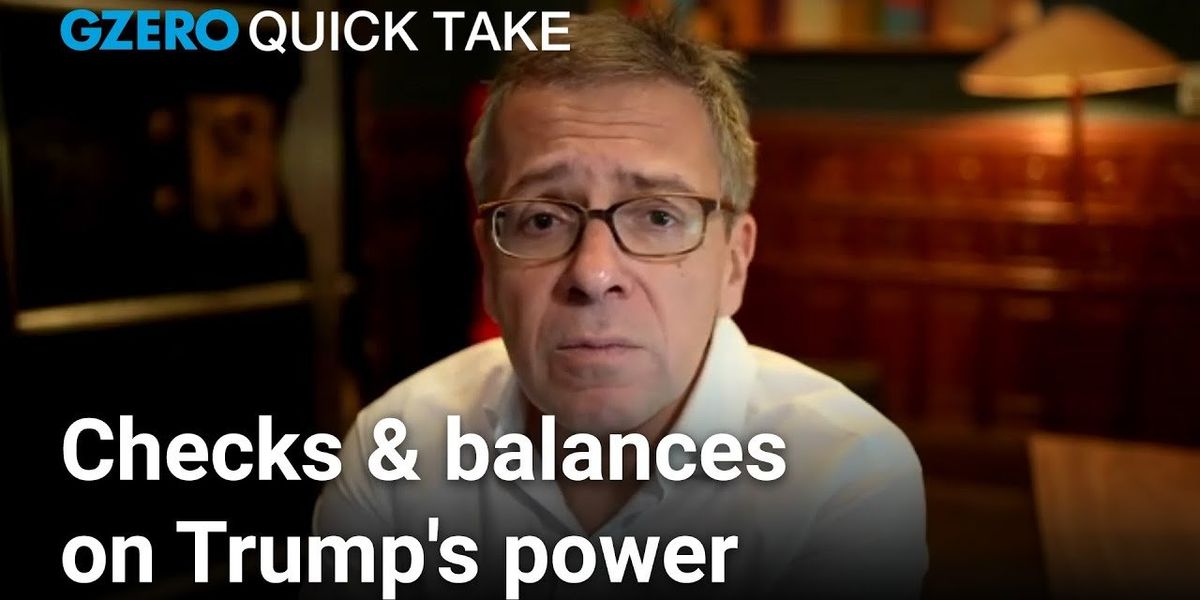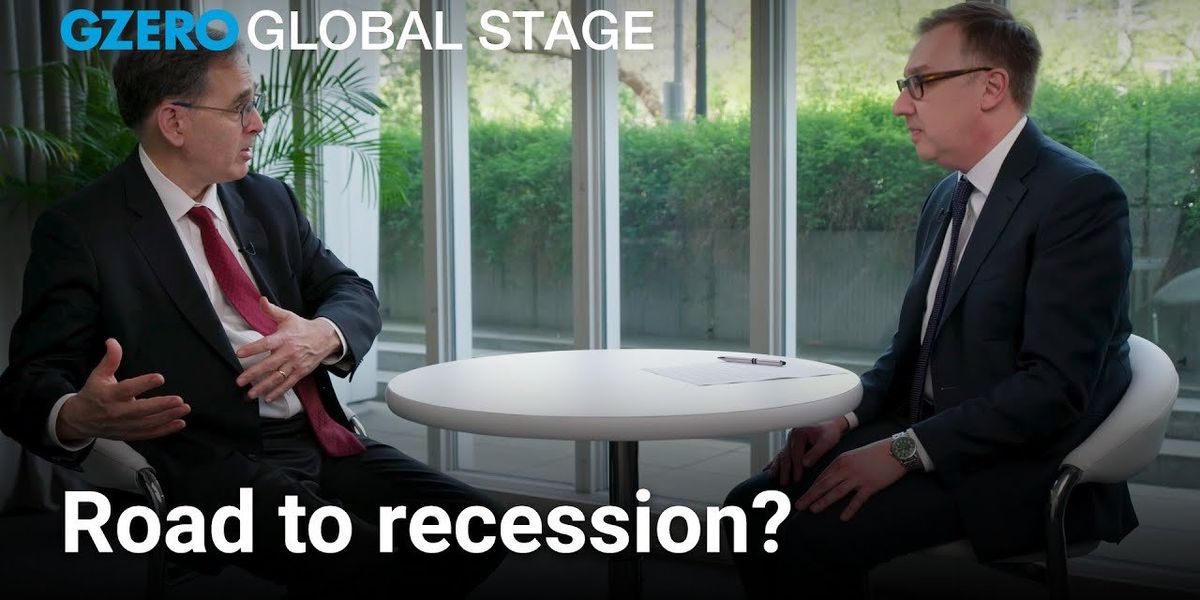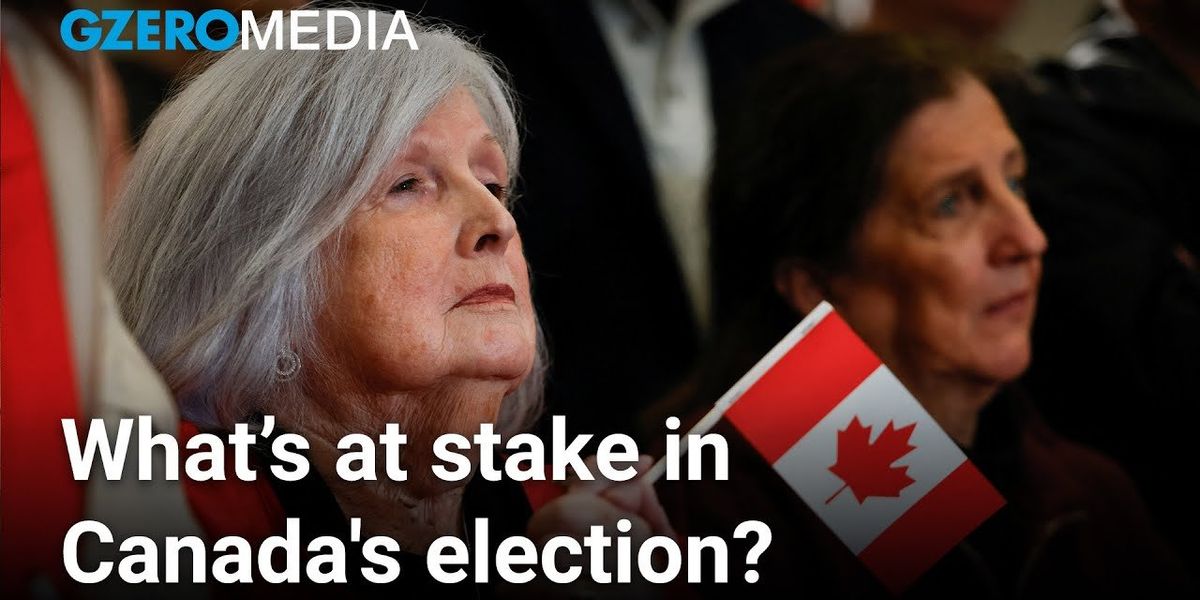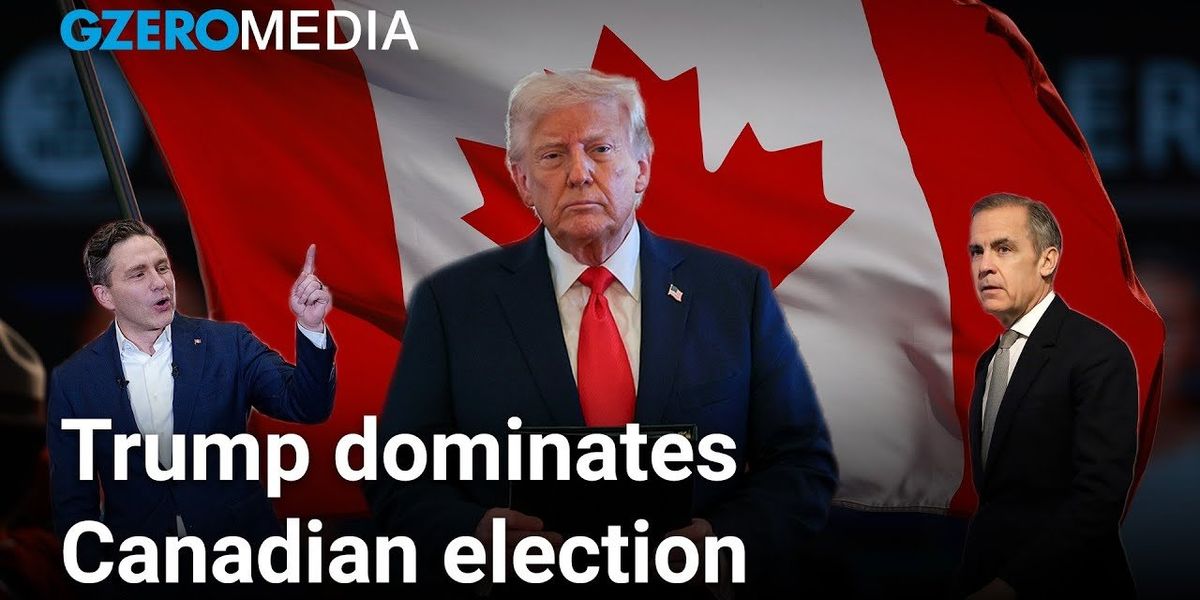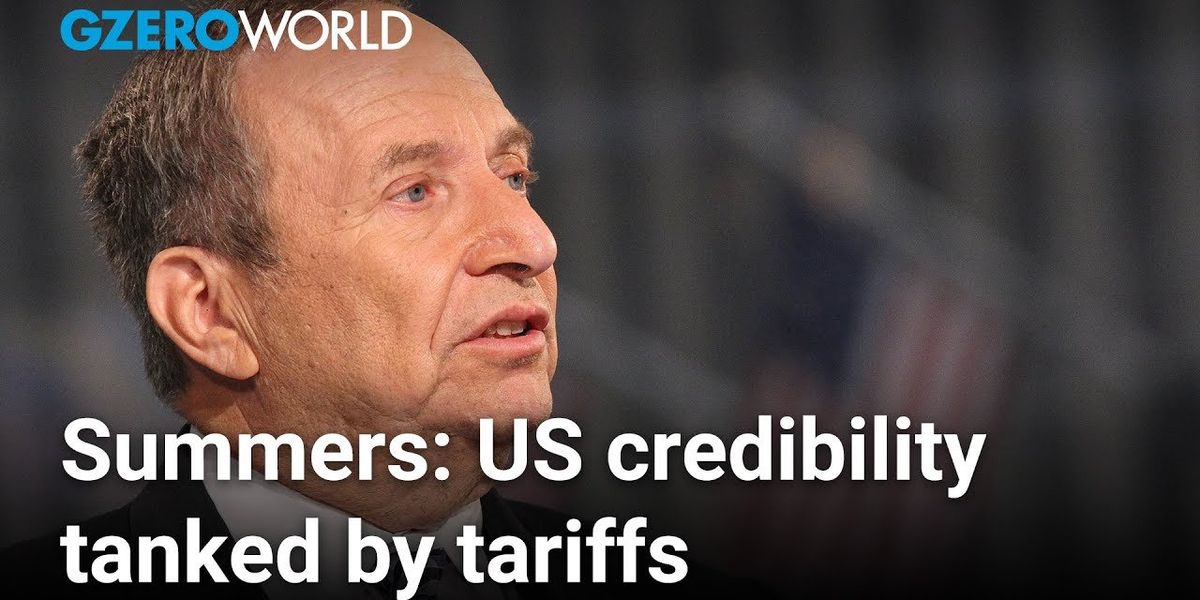Trending Now
We have updated our Privacy Policy and Terms of Use for Eurasia Group and its affiliates, including GZERO Media, to clarify the types of data we collect, how we collect it, how we use data and with whom we share data. By using our website you consent to our Terms and Conditions and Privacy Policy, including the transfer of your personal data to the United States from your country of residence, and our use of cookies described in our Cookie Policy.
{{ subpage.title }}
Trump’s ‘less is more’ message is un-American
Ian Bremmer's Quick Take: I wanted to spend a few moments talking about a quote I heard from Trump this weekend. Did an interview where he said, "I don't think a beautiful baby girl that's 11 years old needs to have 30 dolls. I think she can have three dolls or four dolls. They don't need to have 250 pencils, they can have five." And my immediate thought was, this is one of the most anti-American things I have ever heard a US president say. I was very surprised by it, honestly. I heard back from a lot of folks and they said, "Well, how about when Trump in the same interview said that he wasn't sure about upholding the constitution? Isn't that worse?" And I'm like, well, yeah, maybe it's worse, but it's not more anti-American. I mean, not knowing how the constitution works or claiming you don't know how the constitution works, that may be bad, but it's not anti-American. But saying we shouldn't be able to buy and have all the stuff we want, that's anti-American.
We Americans want maximum stuff. I remember growing up with George Carlin, you needed places to put your stuff. When you ran out of places to put your stuff, you had a garage so that you could put your stuff there so that you could go out and buy more stuff. This isn't new. We've had this for a very long time, and this is Trump's in, right? He puts his name on planes and buildings. It's not about less but better high quality stuff. That's other countries. Japan does less amount of stuff, but very, very high quality. Takes decades to make that kind of stuff. Artisans spend their entire lives sort of on one carving or one piece of chocolate. No, we don't do that. We are a country of 250 breakfast cereals in the cereal aisle, and that's separate from granola. I'm just talking about cereal.
This is Trump's id. This is the guy that has turned the Oval Office into Versailles because there wasn't enough gold plating, gold gilding. Nobody reflects the supremacy of American consumption better than Donald Trump. Trump steaks. Trump watches. Trump gold sneakers. Trump coin. More stuff. And look, when he said beautiful baby girls have dolls, that's on brand, right? No question. Not boys. Boys can't have dolls. Boys have action figures which are basically dolls, but they sound tougher, and they should ideally have guns or pencils. Boys can have pencils. For me, Tonka truck, right? Maybe he didn't have time to think of a Tonka truck. It was a live interview, but a Tonka yellow dump truck. That was my favorite toy without question as a beautiful baby boy of 11 years old growing up. But either way, the point is not that an 11-year-old beautiful baby girl needs 11 or 20 or 30 dolls, but what if they want 30 dolls?
And God forbid that dad before 'Liberation Day' couldn't afford 30 dolls, but could only afford three dolls. What do you do then? Now, that girl only gets a third of a doll, right? Which part of the doll then? Just the head. I guess just the head. Because then at least you can keep an imaginary conversation going on with the doll. You don't want just the feet. And by the way, Zuckerberg I think can help with that since he's all about AI so that Americans who don't have as many friends as the average American wants to have can have that many friends. Now, that's super dystopian, but it's not anti-American. That's American. If we can't have as many friends as we want, we should be able to buy those friends, even if they're not real people. That's American. So look, Trump isn't actually saying we can't have 30 dolls, but Trump is saying it's going to take time with all the tariffs that we have to be patient.
And look, patience is anti-American. You don't elect Trump if you're patient. You elect Trump because you want stuff now. What, is Trump now going to say that America's going to embrace the slow food movement? That's not American. Trump's the guy that won the election after serving at McDonald's, right? And by the way, not serving at the counter, but serving at the drive-thru because it's not enough to have fast food, but you have to fast food even faster than you would normally have fast food by going into the restaurant. Trump is the guy that made RFK Jr. eat McDonald's on the Trump plane. Trump's the guy that brought hundreds of thousands of calories of McDonald's for that football team when they visited the White House, when we may have some of the world's highest levels of obesity. But if you just give us a minute, we will also have the world's highest consumption of Ozempic. Mr. President, make America great again. Thank you.
Ian Bremmer on Trump's first 100 days
Ian Bremmer's Quick Take: It is a hundred days of President Trump's second administration. How's he doing? And the answer is not so well, certainly not if you look at the polls. Worst numbers for first a hundred days of any president since they've been taking those polls. Markets, of course, down, global economy also down, so much of this self-imposed. And it's not the big-picture policy ideas. The things that Trump says he wants to do are not only popular, but they're also sensible policy: end wars, secure the border, and fair trade. Running on those three planks would work for pretty much anyone in the United States, the things that Trump is committed to, the things that previous administrations, including Biden and the promise of Harris, had not been particularly effective at. But the implementation has been abysmal. The lack of interest in policy specifics, lack of ability to effectively execute, and the dysfunction inside the Trump team/teams, economy, national security has been really challenging.
Tariffs, of course, so far have been the big problem, big internal fight on what it was that Trump should do and for what purpose. In terms of the purpose of these tariffs, you had so many ideas, and a lot of them were mutually contradictory. You're meant to raise revenue and lower taxes and reshore manufacturing and balance deficits and decouple from China and improve national security and on and on and on. These tariffs were going to be a panacea for absolutely everything, and you can't accomplish all of it. And that means that all of the fights that are going on, these countries don't know what the Trump administration actually wants. Bessent, the secretary of treasury, came in with one idea, and Peter Navarro, who initially won, came in with a second, the senior trade advisor in the White House, and Lutnick sort of had a third, and now Bessent is in charge for now, nominative.
Of course, Trump is really in charge, and Trump isn't interested in the specifics. He just wants deals. He wants wins. And he's saying, "Well, you guys, you other countries, you tell us what you're going to do. Well, it's not our job to tell you what we want, even though we're the ones that are expecting these deals to come together." And of course, it's happening with the Americans picking fights with all of these countries, literally everybody in the world simultaneously. And the impact that's going to have on the American economy is going to be dramatic. It's going to be long-lasting. It'll be, in many ways, as big as the pandemic, but completely self-imposed.
And even if deals were put together tomorrow, and they won't be, with the Europeans, with the Mexicans and Canadians, with the Chinese in particular, you'd already have a massive long-term disruption because the supply chains, the tankers, the contracts have already been severed for a period of time. And every day this goes on is a day that it's going to get worse. So that's going to lead to a lot of inflation in the United States, going to lead to a lot of bankruptcies and need for stimulus in other countries around the world, and the average voter's not going to be happy about that at all, which does help to explain why they did Liberation Day the day after elections in the US, special elections in Wisconsin and Florida and elsewhere.
Ending wars, Gaza did have a ceasefire early on, but not now. And now Trump is planning his trip to the Gulf and doesn't have Israel on the schedule, at least not yet, because there's more fighting happening between the Israeli Defense Forces and what's left of Hamas. And that fighting is not something Trump wants to see. Let's see how successful he is at bringing it to a ceasefire.
More important for everyone right now in the United States is the Russia-Ukraine War. The Americans are pushing to end that war, and Trump has had some success in getting the Ukrainians to the table because they understand that the or else is their intelligence and defense support from the US will be shut down, as it was suspended, so they're taking it very seriously. But the Russians are not because Trump has not displayed much of an or else for the Russians, hasn't said directly that if Russia refuses to do a ceasefire, that the US will provide more support for Ukraine, even though Trump advisors were saying that before he became president, has said, "Well, maybe there'll be secondary sanctions." But Trump is not making this very serious for Putin, and so Putin isn't taking it very seriously. Nobody thought he was really going to end the war in a day, but it's been a couple of months of effort, and clearly now Trump and team are losing patience and it's looking increasingly that they might walk away, which is why they're engaging with the Iranians and why, heck, Kim Jong Un probably is going to get a call at some point, right? Because Russia-Ukraine not working so well. So much for ending those wars.
And then on the border front, where Trump is having much more success in terms of policy, you don't see illegal immigrants coming into the US at anywhere close to the numbers they were under Biden or during Trump first term, and that has been a response to effective US policy. But there's also been overreach in terms of refusal to carry out the rulings of federal justices and even the Supreme Court, and that overreach is something that most Americans oppose. So even in the area where Trump is doing the best, his numbers are actually not as favorable as you might otherwise expect because of the dysfunction and because of the overreach of a more revolutionary Trump orientation.
Look, even DOGE, where I was kind of hoping in the early days that DOGE was certainly going to be effective at taking a lot of the corruption and the overspending out of the US government, but much less has been done on that front. There's been lots of claims of fraud, but very little evidence of actual fraud. There's been lots of claims that they were going to take two trillion, then one trillion, then maybe 150 billion, and now looks like less of that with Elon in charge of DOGE. And the focus that they have had has been much more politicized, much more ideological. Anything that looks like DEI or woke, let's just remove all of it and not necessarily do it with a scalpel, but more with a sledgehammer or a chainsaw, which means a lot of important programs get caught up, along with programs that no Americans should be funding.
And so overall, it's been a very challenging first hundred days. This is very much a move fast and break things approach. They are moving very fast. They are breaking a lot of things. There's not a lot of building, at least not yet. And a lot of Americans, while they feel that their government is inefficient and bloated, very few Americans want to see the government be broken further than it already is and less effective than it is, and that is so far what people are seeing. They're seeing it at home and they're seeing it internationally.
And they're not seeing a lot of restraint, even as mistakes are made, not only because Trump is never going to admit to have made any mistakes, of course that is something that you see from pretty much every president, but also, unlike most presidents, he's surrounded by people that don't tell him when he gets things wrong. And that is very different from Trump's first term, and that's a problem because you want to have people, irrespective of how loyal they are to you, you want them to be loyal first and foremost to the country. But Trump doesn't want that. He wants them loyal to him before they're loyal to the country, and that means not giving him information when he screws up because he will retaliate against them. And that's going to get you negative outcomes, I think, not just for the first a hundred days, but also for a much longer period of time in the United States and internationally. I hope I'm wrong. I certainly want to see him succeed, I want to see the country succeed, but that is not the trajectory that we are now on.
That's it for me, and I'll talk to y'all real soon.
Protecting your money in today's unpredictable market
“When things are going fine, nobody really tests the skills and talents of their financial advisor, but this is a moment where really good advice can be extraordinarily powerful,” says Margaret Franklin, CFA Institute's CEO and President.
In conversation with GZERO’s Tony Maciulis, Franklin describes the current financial climate as “maximum uncertainty,” rating it a 10 out of 10 on the risk scale. Recent unpredictable US trade policies have sent market volatility soaring, leaving many people and investors uncertain about their financial and portfolio management decisions. The usual conditions of predictability and reliability have been upended, making it more important than ever to seek guidance from a Chartered Financial Analyst (CFA), Franklin recommends. She warns that the most “common destructive behavior” for a portfolio is abandoning a sensible program just when you need to stay the course.
Franklin also highlights growing concerns about “finfluencers” on platforms like TikTok and Instagram, who often lack proper qualifications and required disclosures. To address this, the CFA Institute is working to provide the public with reliable financial education and resources, helping people better understand the complexities and risks of today’s unpredictable environment.
This conversation is presented by GZERO in partnership with Microsoft from the IMF-World Bank Spring Meetings in Washington, D.C. The Global Stage series convenes global leaders for critical discussions on the geopolitical and technological trends shaping our world.
Trump’s America: A kleptocracy but not a police state
Ian Bremmer's Quick Take: I want to talk about checks and balances in the US political system. I get so many questions about this of course, because the United States today is the principal driver of geopolitical uncertainty, of global economic uncertainty. And people want to understand, is this the end of globalization? Is it the end of US democracy?
Everyone has their knobs politically turned up to 11 on everything, and that's very undifferentiated. So, how do we think about this? I want to give you a few thoughts on what is and what isn't a permanent change. What is and what isn't a serious threat and concern. Particularly big picture on the nature of the US political system.
I've said a number of times that I consider the US to be by far the most kleptocratic and dysfunctional political system among all of the advanced industrial democracies. I've said that not just in the last few months, but for years now, and that predates Trump. Trump has sped up the kleptocratic impulses in the United States.
The second most powerful person in the White House on President Trump, at least for now with an official position, is also the wealthiest person on the planet who continues to own and run six companies. Obviously, it's kleptocratic. Trump is very much pay for play.
If you're a TikTok investor and you give him money, he flips his position on TikTok. Very direct, very dramatic, but the United States has been kleptocratic for decades. It is the country where if you have money, you can use it to gain access to power and that will get you outcomes you want. Whether it's a specific tax code or a specific regulation or lack thereof.
That is much more true in the US than it is in Canada or Germany or Japan or Australia or New Zealand, or the Nordics, any of the advanced industrial democracies, the rich democracies, right, which is the cohort that you look at when you think about the US political system.
And that's interesting because when Trump leans in on that kleptocracy, when he expands it it may make a number of business leaders and bankers uncomfortable. It's unseemly, but they're used to it. They know how that works. They already have their lobbyists and their pacts. They already have their comms teams, they've got their people on K Street lined up.
They already know what it means to pay for an inauguration and to get people that say they have access to the family of the administration and they can help you as a consequence. They're willing to spend money on that and to make favors for that, all of the offer internships for that, all of those things, right?
And as a consequence, you don't get pushback on that, right? If Trump is going to shake down a corporation or else, they'll pay. And that's true across the board. You don't see a lot of public courage as a consequence from the business environment in the US.
The US does not have a long-standing policy of authoritarianism. The US is not used to dictatorship. And so when Trump engages in things that feel like a direct threat to the rule of law on say the ability of law firms to conduct their core business, which is representing anyone vigorously, that deserves defense.
Yeah, a couple of firms will bend the knee, but there'll be a lot of internal pushback and most won't because that's something that is beyond the pale.
And I think the same thing is true about academic freedom. Is when the Trump administration says whether you like the politics or not, that they're going to cut off funding if you don't eschew some of the independence that you have exerted and you have as your right as you do as a public institution, as a university.
And that maybe they should take away your tax-free status, all that kind of thing. Then you see a couple of universities will bend the knee, but most won't. And there'll be very strong pushback on that.
And so what I think is happening is that the US is going to continue to become much more kleptocratic beyond Trump, and I don't see anything that's going to stop that. That is a serious problem long-term in terms of reputational capital for the United States, both domestically in attracting capital and also on the global stage.
But I also see significant pushback on authoritarian impulses, and I think it's far less likely that the US is slipping into dictatorship. And so when the Financial Times writes that the US is halfway towards becoming a police state, I say, "No, not at all."
The US may well be today the most unfree of advanced democracies, but it is not the most free of authoritarian states because it's not authoritarian. You still have an opposition party that you can vote for and that says whatever they want.
I don't feel in any way like I am potentially going to risk arrest or my liberties by virtue of saying to you exactly what I think about what's happening domestically, internationally. If that starts to stop, believe me, you're going to hear from me before you hear it from somebody else. So that's one point.
Second point is that for Trump to be successful in subverting the checks and balances on him, if he wants to win as a revolutionary president, he has to do two different things. The first is he has to actually erode those institutions, those norms, those values, he has to weaken them. But then he has to actually execute on being the most powerful.
Because if you want to live by the law of the jungle, you have to actually be the effective apex predator. And what we've seen is that Trump has been reasonably effective at not paying attention to rule of law norms.
Look at trade treaties, USMCA. He's completely abrogated by virtue of saying, "Nope, national security emergency, I'm just putting tariffs on." That's clearly not what the Mexicans and Canadians signed up for. He doesn't care. And he is doing that with reckless abandon in all sorts of different places domestically and around the world.
But to be the effective apex predator, you have to not only erode the norms and values, but then you have to actually perform. What we're seeing is that having a fight with literally everyone simultaneously, your adversaries and your allies internationally and domestically turns out to be really hard.
I mean, even the mighty lion doesn't go after an entire herd of wildebeests simultaneously. You pick off an injured one, a little one, maybe a juvie, right? And what Trump is finding out is that he's going after a herd of wildebeest and he's getting kicked in the head.
He's done that internationally with, let's put 145% tariffs on China, the second biggest, strongest, most powerful economy in the world. And by the way, with a political system that's much more capable of waiting out and taking pain than the Americans are, because it's an actual authoritarian regime with a multi-generational rule from a communist party that is very consolidated.
So the Chinese are saying, "Oh yeah, we'll hit you back." And now Trump is saying, "Uh-oh, maybe bad idea." And he's also seeing that, for example, with his decision to go after Fed Chief Jerome Powell. He said how horrible Powell is and, "I should fire him. I should get rid of him." And a few days later he said, "Well, I'm not going to fire Powell."
Well, it's not like Powell's done anything differently. He's not behaving in any way that Trump would want, but Trump has recognized that trying to kick Powell in the head is a really bad idea because the markets are throwing up all over it and the business community and other countries and his own advisors.
It's harder to get that feedback to Trump because he has a group of advisors, some of whom are very capable, some of whom are completely incompetent, but all of whom are far more loyal and therefore far less willing to give him information he does not like.
But the bigger the obvious failures are, the more clear it is that you can't fight all the wildebeest simultaneously the more that information is going to get through to Trump and we are seeing that start to happen.
So, in other words, I do see snapback functions that are constraining what Trump is trying to accomplish. They are not coming from rule of law. They're not coming from the established institutions, which turn out to be a lot weaker than a lot of people had hoped or believed.
But they are coming from other powerful forces domestically and internationally that are capable of standing up and saying, "No, we're not going to take that." And you all know courage is contagious. You suddenly see some big guns that are coming out and saying, "No, we're not going to take it," and that actually provides space for other people to do it too.
And so at the end of the day, leading by example really matters, especially when something's happening that is obviously deeply damaging to yourself, to your family, to your colleagues, to your business, to your country, and to the world. And I think that's playing out right now.
Don't call me an extraordinary, unrelenting optimist. It's not that I am an optimistic person by nature, but this is coming from analysis. I'm more than capable of telling you when I think things are going to hell and predicting things that I really don't want to have happen.
This, on the other hand, is something I would really like to see happen, which is effective checks and balances on unhinged decision-making and I am starting to see that some of that is playing out. That's it for me, and I hope everyone's doing well. I'll talk to you all real soon.
Global economic outlook: Is a recession already here?
“We’re heading toward a substantial U.S. recession,” said Robert Kahn, Eurasia Group’s Managing Director, Global Macro. “We may even be in one now.”
That notion challenges the official economic outlook released this week by the International Monetary Fund, which was more cautious in its assessment. However, it more closely mirrors what experts are saying in the halls at the IMF-World Bank Spring Meetings currently underway in Washington, D.C.
In a conversation with GZERO’s Tony Maciulis, Kahn explained the state of the global economy before President Donald Trump’s April 2 “Liberation Day” and where things stand now. Unlike past crises triggered by external shocks, this one, he argues, is driven by the U.S. administration’s abrupt and sweeping trade policy changes, alongside tension between the White House and the Federal Reserve. These factors make the downturn both unpredictable and unprecedented.
“We don’t have a model for this,” Kahn said. “There’s no course I took in school that’s directly relevant to what we’re living with.”
This conversation is presented by GZERO in partnership with Microsoft from the IMF-World Bank Spring Meetings in Washington, D.C. The Global Stage series convenes global leaders for critical discussions on the geopolitical and technological trends shaping our world.
What Canada’s main parties are running on in upcoming election
Canada’s 45th general election is less than two weeks away, and the nation faces a fraught political climate fueled by President Donald Trump’s tariffs and annexation threats towards the country. The election's outcome could have far-reaching impacts on Canada’s future and position in a fragmenting world. In an exclusive interview, GZERO’s Tasha Kheiriddin sits down with Eurasia Group‘s senior advisor John Baird and Vice Chairman Gerald Butts to unpack what’s at stake in Canada’s election, including key political players and the strategies behind their campaigns.
Butts, former principal secretary to Prime Minister Justin Trudeau and a key Liberal strategist, says Carney is seeking a public mandate after taking over during Canada’s longest-running minority Parliament. Baird counters that Carney aims to ride early popularity and break from the Trudeau legacy.
Despite clear ideological divides, both Butts and Baird agree on one point: Canada needs a strong majority government. Baird warns that, “when you have such a small number of Members of Parliament, it’s like the tail wagging the dog,” expressing concern over the instability of minority rule. Butts echoes the sentiment, stating the country would be “far better served by a strong government of either political stripe.”
With Canadians heading to the polls, the world will be watching closely. The 2025 Canada election could determine not just the nation's economic path but its place on the global stage.
Watch full interview: Canadians head to the polls — and into the Trump vortex
Special interview: Canadians head to the polls — and into the Trump vortex
With just over a week until the Canadian election, GZERO’s Tasha Kheiriddin sat down with two senior advisors at Eurasia Group to get their take: Vice Chairman Gerald Butts, who is a former advisor to Liberal Prime Minister Justin Trudeau, and John Baird, former Cabinet minister under Conservative Prime Minister Stephen Harper.
Here’s what they had to say:
Why is Canada in an election campaign? “The prime minister needed a mandate from the people, not just his party,” said Butts, referring to newly minted PM Mark Carney, who took over from Trudeau in March.
Baird was more blunt: “Carney wanted to separate himself from the NDP–Trudeau era.” Which he seems to be doing: Under his watch the Liberals have soared nearly 20 points in the polls and are currently predicted to form a government.
Who are the main players? Carney, the former governor of the Bank of Canada and the Bank of England, presents “a safe, fiscally responsible concept” in Butts’ view. His main rival, populist Conservative leader Pierre Poilievre, brings “a fresh approach” according to Baird, who served with Poilievre in Parliament. He sees Poilievre as “best able to speak to US President Donald Trump and his administration.”
What’s really on the ballot? The main issue is who can most effectively deal with Trump, whose tariffs and musings about making Canada the “51st state” have enraged Canadians. So far, voters give top marks to Carney on that question. But whichever party wins, Butts and Baird agree that the next PM faces a hostile White House. “We’re starting from scratch,” warned Butts, citing the breakdown in what used to be one of the world’s closest bilateral relationships.
Minority or majority? Both men think that a minority government would be a bad outcome. “You don’t want to be checking in with a party leader with 8% in the polls before talking to the president of the United States,” said Butts, referring to Canada’s smaller parties, the NDP and Bloc Québécois. “It’s the tail wagging the dog,” added Baird.
Advice to the next PM for dealing with Trump? “Don’t get ‘Zelenskied’ — and be prepared,” they agreed. And to the victor go the spoils, even if that victor will take over at one of the most fraught moments in Canada’s history.
“The worst day in government,” Baird quipped, “is still better than the best day in opposition.”
Watch the full interview above.
"We've lost enormous credibility around the world" because of tariffs - Summers
On GZERO World with Ian Bremmer, economist Larry Summers slams the Trump administration’s trade war as “the worst, most consequential, self-inflicted wound in US economic policy since the Second World War.” He says there’s still time to limit the damage—if the tariffs are walked back quickly—but warns that the global fallout is already underway. “Even in the best imaginable place, we have lost enormous credibility in the world,” Summers says, adding that the unpredictability rattles everything from debt markets to US alliances.
When Bremmer asks what the Trump administration is actually trying to accomplish, Summers is at a loss. "I don't see this as a rational way of either pursuing the objective of strengthening US manufacturing or the objective of reducing other countries' trade barriers." And the damage, Summers adds, will be extensive and long-lasting.
"We have lost enormous credibility in the world. We've created a large uncertainty premium about what we're going to do next, and we're going to be seen as a less reliable country...this kind of truculence does not go unnoticed, and it is not immediately forgotten."
Watch full episode: Larry Summers: Trump's trade war the "worst self-inflicted wound since WWII"
GZERO World with Ian Bremmer, the award-winning weekly global affairs series, airs nationwide on US public television stations (check local listings).
New digital episodes of GZERO World are released every Monday on YouTube. Don't miss an episode: subscribe to GZERO's YouTube channel and turn on notifications (🔔).GZERO World with Ian Bremmer airs on US public television weekly - check local listings.
